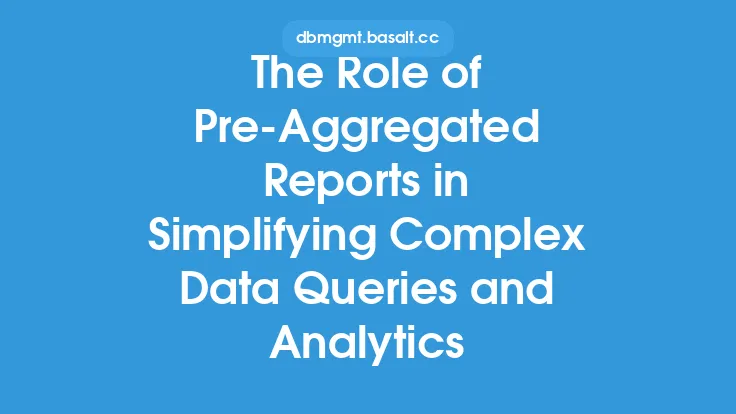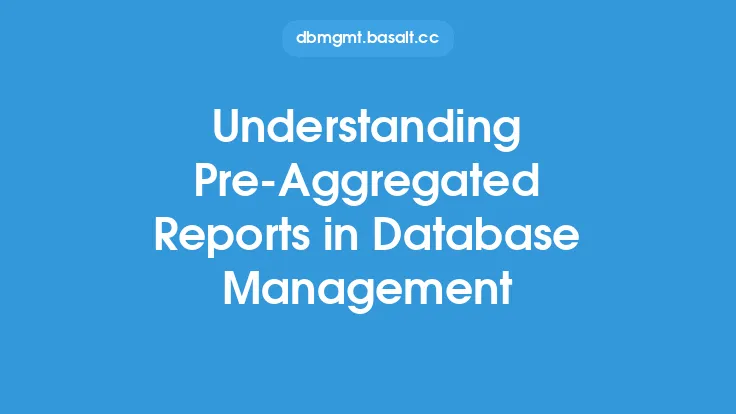Data analysis is a crucial aspect of business decision-making, and it relies heavily on the ability to extract insights from large datasets. One technique that has gained popularity in recent years is the use of pre-aggregated reports, which involves pre-computing and storing aggregated data in a database to improve query performance and reduce the complexity of data analysis. In this article, we will delve into the benefits of pre-aggregated reports for data analysis, exploring how they can simplify complex data queries, improve data visualization, and enhance decision-making.
Introduction to Pre-Aggregated Reports
Pre-aggregated reports are a type of data denormalization technique that involves pre-computing and storing aggregated data in a database. This technique is particularly useful for datasets that are frequently queried, as it reduces the need for complex queries and improves query performance. By pre-aggregating data, businesses can simplify their data analysis processes, reduce the load on their databases, and improve the overall efficiency of their data-driven decision-making.
Benefits of Pre-Aggregated Reports
The benefits of pre-aggregated reports are numerous, and they can have a significant impact on the efficiency and effectiveness of data analysis. Some of the key benefits include:
- Improved query performance: Pre-aggregated reports reduce the need for complex queries, which can significantly improve query performance and reduce the load on databases.
- Simplified data analysis: By pre-aggregating data, businesses can simplify their data analysis processes, making it easier to extract insights from large datasets.
- Enhanced data visualization: Pre-aggregated reports can be used to create interactive and dynamic dashboards, making it easier to visualize data and extract insights.
- Faster decision-making: By providing quick and easy access to aggregated data, pre-aggregated reports can enable businesses to make faster and more informed decisions.
Technical Benefits of Pre-Aggregated Reports
From a technical perspective, pre-aggregated reports offer several benefits, including:
- Reduced query complexity: Pre-aggregated reports reduce the need for complex queries, which can simplify the data analysis process and reduce the load on databases.
- Improved data compression: Pre-aggregated reports can be compressed more efficiently than raw data, which can reduce storage costs and improve data transfer times.
- Enhanced data security: By storing aggregated data in a separate database or table, businesses can improve data security and reduce the risk of data breaches.
- Better data governance: Pre-aggregated reports can be used to implement data governance policies, ensuring that data is accurate, complete, and consistent across the organization.
Use Cases for Pre-Aggregated Reports
Pre-aggregated reports have a wide range of use cases, including:
- Business intelligence: Pre-aggregated reports can be used to create interactive and dynamic dashboards, making it easier to visualize data and extract insights.
- Data warehousing: Pre-aggregated reports can be used to improve the performance of data warehouses, reducing the need for complex queries and improving query performance.
- Big data analytics: Pre-aggregated reports can be used to analyze large datasets, reducing the need for complex queries and improving query performance.
- Real-time analytics: Pre-aggregated reports can be used to provide real-time insights, enabling businesses to make faster and more informed decisions.
Best Practices for Implementing Pre-Aggregated Reports
To get the most out of pre-aggregated reports, businesses should follow best practices, including:
- Identifying frequently queried data: Businesses should identify the data that is most frequently queried and pre-aggregate it to improve query performance.
- Using data compression: Businesses should use data compression techniques to reduce storage costs and improve data transfer times.
- Implementing data governance policies: Businesses should implement data governance policies to ensure that data is accurate, complete, and consistent across the organization.
- Monitoring and maintaining pre-aggregated reports: Businesses should regularly monitor and maintain their pre-aggregated reports to ensure that they remain accurate and up-to-date.
Conclusion
In conclusion, pre-aggregated reports offer a wide range of benefits for data analysis, including improved query performance, simplified data analysis, enhanced data visualization, and faster decision-making. By understanding the benefits and use cases of pre-aggregated reports, businesses can improve the efficiency and effectiveness of their data-driven decision-making. Whether you are a business intelligence analyst, a data warehousing specialist, or a big data analyst, pre-aggregated reports are a powerful tool that can help you extract insights from large datasets and make better decisions.





